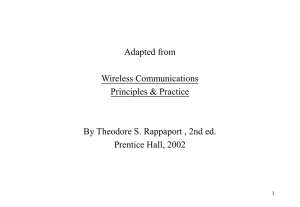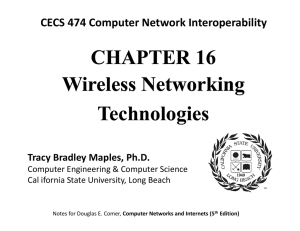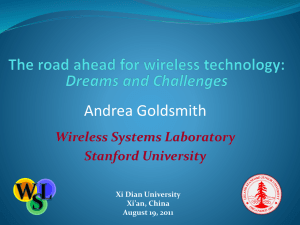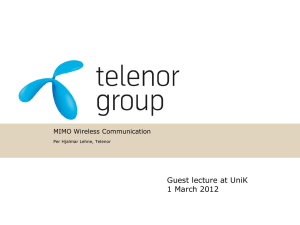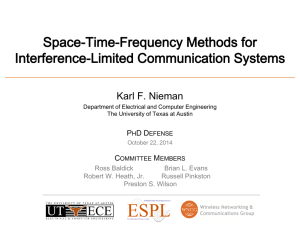A Robust and Adaptive Communication System for Intelligent
advertisement
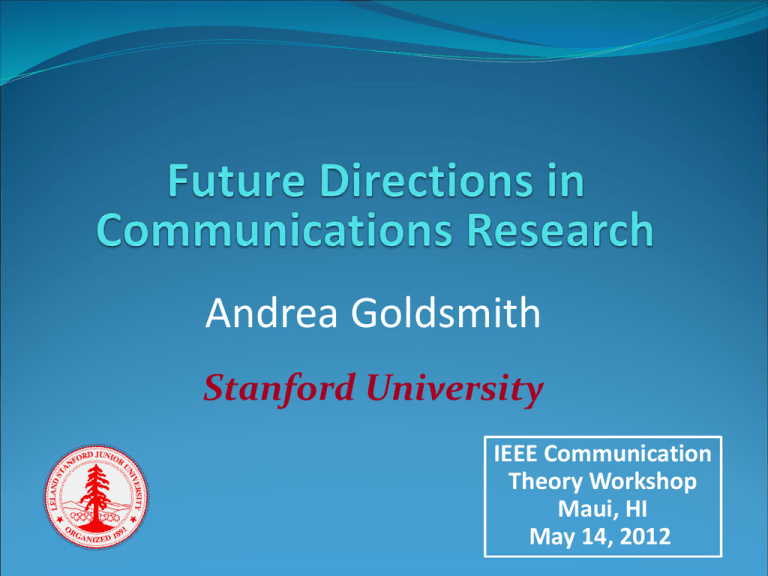
Andrea Goldsmith Stanford University IEEE Communication Theory Workshop Maui, HI May 14, 2012 Future Wireless Networks Ubiquitous Communication Among People and Devices Next-generation Cellular Wireless Internet Access Wireless Multimedia Sensor Networks Smart Homes/Spaces Automated Highways Smart Grid Body-Area Networks All this and more … Future Cell Phones Everything in one device Burden for wireless this performance is on the backbone network San Francisco BS BS LTE backbone is the Internet Internet Nth-Gen Cellular Phone System Nth-Gen Paris Cellular BS Much better performance and reliability than today - Gbps rates, low latency, 99% coverage indoors and out Careful what you wish for… Source: FCC Source: Unstrung Pyramid Research 2010 Growth in mobile data, massive spectrum deficit and stagnant revenues require technical and political breakthroughs for ongoing success of cellular Can we increase cellular system capacity to compensate for a 300MHz spectrum deficit? Without increasing cost? or power consumption? What would Shannon say? Are we at the Shannon limit of the Physical Layer? We don’t know the Shannon capacity of most wireless channels Time-varying channels with memory/feedback. Channels with interference or relays. Uplink and downlink channels with frequency reuse, i.e. cellular systems. Channels with delay/energy/$$$ constraints. Rethinking “Cells” in Cellular Small Cell Coop MIMO How should cellular systems be designed? Relay DAS Will gains in practice be big or incremental; in capacity or coverage? Traditional cellular design “interference-limited” MIMO/multiuser detection can remove interference Cooperating BSs form a MIMO array: what is a cell? Relays change cell shape and boundaries Distributed antennas move BS towards cell boundary Small cells create a cell within a cell Mobile cooperation via relaying, virtual MIMO, analog network coding. Are small cells the solution to increase cellular system capacity? Yes, with reuse one and adaptive techniques (Alouini/Goldsmith 1999) Area Spectral Efficiency A=.25D2p S/I increases with reuse distance (increases link capacity). Tradeoff between reuse distance and link spectral efficiency (bps/Hz). Area Spectral Efficiency: Ae=SRi/(.25D2p) bps/Hz/Km2. The Future Cellular Network: Hierarchical Architecture Today’s architecture MACRO: solving • 3M Macrocells serving 5 billion users initial coverage • Anticipated issue, existing network PICO: solving street, enterprise & home coverage/capacity issue FEMTO: solving enterprise & home Picocell Macrocell coverage/capacity issue 10x Lower COST/Mbps (more with WiFi Offload) 10x CAPACITY Improvement Near 100% COVERAGE Femtocell Future systems require Self-Organization (SON) (and WiFi Offload) SON Premise and Architecture Mobile Gateway Or Cloud Node Installation SoN Server Self Healing Initial Measurements IP Network SON Self Configuration Measurement Server Self Optimization X2 X2 Small cell BS Macrocell BS X2 X2 Algorithmic Challenge: Complexity Optimal channel allocation was NP hard in 2nd-generation (voice) IS-54 systems Now we have MIMO, multiple frequency bands, hierarchical networks, … But convex optimization has advanced a lot in the last 20 years Innovation needed to tame the complexity Green Cellular Networks Pico/Femto Coop MIMO Relay DAS How should cellular systems be redesigned for minimum energy? Research indicates that significant savings is possible Minimize energy at both the mobile and base station via New Infrastuctures: cell size, BS placement, DAS, Picos, relays New Protocols: Cell Zooming, Coop MIMO, RRM, Scheduling, Sleeping, Relaying Low-Power (Green) Radios: Radio Architectures, Modulation, coding, MIMO Gerhard Fettweis’ talk Antenna Placement in DAS Optimize distributed BS antenna location Primal/dual optimization framework Convex; standard solutions apply For 4+ ports, one moves to the center Up to 23 dB power gain in downlink Gain higher when CSIT not available 6 Ports 3 Ports Coding for minimum total power Is Shannon-capacity still a good metric for system design? X5 B1 B2 B3 Computational Nodes B4 X6 X7 X8 On-chip interconnects Extends early work of El Gamal et. al.’84 and Thompson’80 Fundamental area-time-performance tradeoffs For encoding/decoding “good” codes, X5 B1 B2 B3 B4 Area occupied by wires Stay away from capacity! Close to capacity Large chip-area More time More power Encoding/decoding clock cycles X6 X7 X8 Reduced-Dimension Communication System Design Compressed sensing ideas have found widespread application in signal processing and other areas. Basic premise of CS: exploit sparsity to approximate a high-dimensional system/signal in a few dimensions. We ask: how can sparsity be exploited to reduce the complexity of communication system design Sparsity: where art thou? To exploit sparsity, we need to find communication systems where it exists Sparse signals: e.g. white-space detection Sparse samples: e.g. sub-Nyquist sampling Sparse users: e.g. reduced-dimension multiuser detection Sparse state space: e.g reduced-dimension network control Compressed Sensing Basic premise is that signals with some sparse structure can be sampled below their Nyquist rate Rob Calderbank’s Talk Signal can be perfectly reconstructed from these samples by exploiting signal sparsity This significantly reduces the burden on the front-end A/D converter, as well as the DSP and storage Enabler for white space, SD and low-energy radios? Only for incoming signals “sparse” in time, freq., space, etc. Software-Defined (SD) Radio: BT Cellular FM/XM A/D GPS DVB-H Apps Processor WLAN Media Processor Wimax A/D A/D DSP A/D Wideband antennas and A/Ds span BW of desired signals DSP programmed to process desired signal: no specialized HW Today, this is not cost, size, or power efficient Compressed sensing reduces A/D and DSP burden Sparse Samples New Channel Sampling Mechanism (rate fs) For a given sampling mechanism (i.e. a “new” channel) What is the optimal input signal? What is the tradeoff between capacity and sampling rate? What known sampling methods lead to highest capacity? What is the optimal sampling mechanism? Among all possible (known and unknown) sampling schemes Capacity under Sub-Nyquist Sampling Theorem 1: Theorem 2: Bank of Modulator+FilterSingle Branch Filter Bank t n(mTs ) q(t) zzzz p(t) zzzz zz y1[n] s1 (t ) zzzzz s(t ) zzzzz y[n] t n(mTs ) equals yi [n] si (t ) t n(mTs ) sm (t ) ym[n] Theorem 3: Optimal among all time-preserving nonuniform sampling techniques of rate fs (ISIT’12; Arxiv) Joint Optimization of Input and Filter Bank Selects the m branches with m highest SNR Example (Bank of 2 branches) low SNR H ( f 2kfs ) X f 2kfs H ( f kfs ) highest SNR X f kfs highest SNR Xf H ( f kfs ) low SNR X f kfs N ( f kfs ) S ( f kfs ) H( f ) 2nd N ( f 2kfs ) S ( f 2kfs ) N( f ) S( f ) Y1 f Capacity monotonic in fs Y2 f N ( f kfs ) S ( f kfs ) How does this translate to practical modulation and coding schemes Ideal Multiuser Detection - Signal 1 = A/D A/D A/D Signal 1 Demod A/D Iterative Multiuser Detection Signal 2 Signal 2 Demod - MUD proposed for LTE = link at -7dB SNR) (closes Why Not Ubiquitous Today? Power and A/D Precision Exploits that number of active users G is random and much smaller than total users (ala compressed sensing) Using compressed sensing ideas, can correlate with M~log(G) waveforms Reduced complexity, size, and power consumption 10% Performance Degradation 1 Tb 0 1 Tb 0 Linear Transformation Reduced-Dimension MUD Tb c1 h1 (t) r(t) g1t 2g4 t n(t) Tb b˜2 b˜i c2 h2 (t) Decision Decision M 1 Tb b˜1 a c ij Tb cM 0 hM (t) j 1 j b˜N Decision Reduced-Dimension Network Design Random Network State Reduced-Dimension State-Space Representation Projection Sparse Sampling Approximate Stochastic Control and Optimization Utility estimation Sampling and Learning Feedback in Communications • Memoryless point-to-point channels: • Capacity unchanged with perfect feedback • Feedback drastically increases error exponent (L-fold exponential) • Feedback reduces energy consumption • Capacity of channels with feedback largely unknown • • • • For channels with memory and perfect feedback Under finite rate and/or noisy feedback For multiuser channels For multihop networks • ARQ is ubiquitious in practice: Why? - Output feedback - CSI - Acknowledgements - Something else? Cognitive Radios PTx PRx CRRx CRTx IP CRTx MIMO Cognitive Underlay CRRx PTx PRx Cognitive Overlay Cognitive radios support new wireless users in existing crowded spectrum without degrading licensed users Utilize advanced communication and DSP techniques Coupled with novel spectrum allocation policies Technology could Revolutionize the way spectrum is allocated worldwide Provide more bandwidth for new applications/services Multiple paradigms Underlay (exploiting unused spatial dimensions) and Overlay (exploiting relaying and interference cancellation) promising The Smart Grid: Fusion of Sensing, Control, Communications carbonmetrics.eu Wireless and Health, Biomedicine and Neuroscience Body-Area Networks Todd Coleman’s Talk Doctor-on-a-chip -Cell phone info repository -Monitoring, remote intervention and services Cloud Ubli Mitra’s talk The brain as a wireless network - EKG signal reception/modeling - Information flow (directed MI) - Signal encoding and decoding - Nerve network (re)configuration Summary Communications research alive and well Communications technology will enable new applications that will change people’s lives worldwide Design innovation will be needed to meet the requirements of next-generation wireless networks A systems view and interdisciplinary design approach holds the key to these innovations
